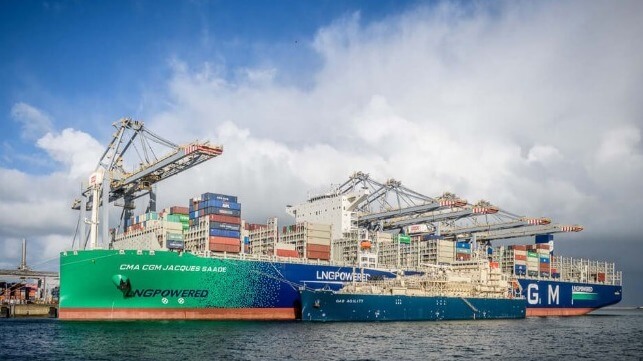CMA CGM Joins Hydrogen Demonstration to Accelerate Bio Fuels

CMA CGM is joining an innovative demonstrator project underway in Europe exploring the production of green hydrogen from renewable power, e-methane, and the reuse of captured CO2 to produce new synthetic fuels. Known as the Jupiter 1000 project being piloted by GRTgaz, the operator of France’s gas transmission network, the goal is to convert renewable power into low-carbon energy that can be stored on a large scale and support efforts such as CMA CGM’s goal to decarbonize its operations.
CMA CGM joins the project seeking to gain from its information to further support the accelerated pace of its fleet transition to low-carbon fuel sources. By providing access to the results of its green hydrogen production, methanation, and CO2 capture projects, Jupiter 1000 will support the shipping company’s efforts to accelerate the development of the production sector for synthetic methane, while CMA CGM will contribute expertise in shipping and logistics and the end-user perspective to support the project’s growth.
Jupiter 1000 has attracted international attention as the project moved from the study phase into demonstrations. The first electrolyzer (producing hydrogen from water and renewable power) injected hydrogen into GRTgaz’s gas transmission network in February 2020. A second electrolyzer, employing a different technology from the previous one, successfully entered service at the beginning of November 2021.
Beyond producing hydrogen, Jupiter 1000 also recycles CO2 by converting it into synthetic gas. The CO2 produced by the boiler at Asco Industrie, a steelmaking plant located nearby, is captured and piped to the Jupiter 1000 site. The CO2 is recycled with hydrogen in a methanation unit. According to the companies involved in the demonstration, the syngas produced can be used instead of fossil fuel gas and employed freely across all transport and distribution networks. Hydrogen methanation facilities as part of the Jupiter 1000 demonstration are due to be commissioned in June 2022.
“The Jupiter 1000 project is of great interest to the CMA CGM Group as part of our efforts to find very low-carbon new fuel sources,” said Christine Cabau Woehrel, Executive Vice-President of the CMA CGM Group, in charge of Industrial Assets and Operations. “We are committed to searching for and industrializing innovative non-fossil fuel gas solutions, with biomethane and synthetic methane. The Jupiter 1000 project will give us access to one of the first demonstrator projects of the kind.”
Sharing expertise and R&D to facilitate the development of energy sources of the future, the companies believe the lessons learned from Jupiter 1000 should open the way for the large-scale production of low-carbon e-methane for the CMA CGM Group’s ships.
The CMA CGM Group has set for itself the goal of net-zero carbon emissions by 2050. In pursuit of this goal, the group is focusing on low-carbon fuels to power its ships. The French company has been investing heavily in LNG-fueled vessels while supporting the development of synthetic fuel sources. CMA CGM highlights that it already has 28 e-methane ready dual-fuel, LNG-powered containerships and will have a total of 44 vessels of this type in service by the end of 2024. The company believes that bioLNG and synthetic methane will play an important part in its future operations.
